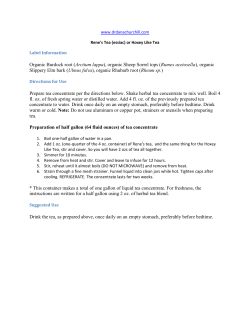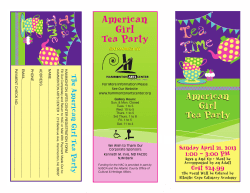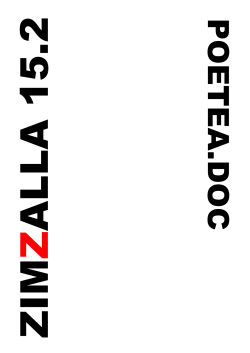
MULBERRY TEA THAI AGRICULTURAL STANDARD
THAI AGRICULTURAL STANDARD TAS 3000-2009 MULBERRY TEA The National Bureau of Agricultural Commodity and Food Standards (ACFS) MINISTRY OF AGRICULTURE AND COOPERATIVES ICS 67.140.10 ISBN XXX-XXX-XXX-X UNOFFICIAL TRANSLATION THAI AGRICULTURAL STANDARD TAS 3000-2009 MULBERRY TEA The National Bureau of Agricultural Commodity and Food Standards (ACFS) MINISTRY OF AGRICULTURE AND COOPERATIVES 50 phaholyothin Jatujak Bangkok 10900 Tel. 0 2561 2277 Fax. 0 2561 3357 www.acfs.go.th Published in the Government Gazette, Publishing & General Works Edition No. 126 Special Part 186 Ngor. On 28 December 2009พิเศษ 186 ง (2) Ad hoc Sub-committee on the Elaboration of Thai Agricultural Standards for Mulberry Tea 1. Mr. Wiroje Kaewruang The Queen Sirikit Institute of Sericulture Chairperson 2. Mr. Somnuek Suchaitanavanit Department for Development of Thai Traditional and Alternative Medicine, Ministry of Public health 3. Mrs. Somkid Ruenpakawut Department of Agriculture 4. Miss Suvannee Teerapapthamkul Department of Medical Service, Ministry of Public Health 5. Mr. Tawee Methakulawat The Office of the Consumer Protection Board, the Prime Minister’s Office 6. Miss Chitra Settaudom Food and Drug Administration, Ministry of Public Health 7. Miss Supaporn Ruengmaneepaitoon Thai Industrial Standard Institute, Ministry of Industry 8. Miss Tassanee Pradyabumrung The National Bureau of Agricultural Commodity and Food Standards 9. Mrs. Chuanpit Simakachorn The Queen Sirikit Institute of Sericulture 10. Assoc. Prof. Surapote Wongyai Faculty of Oriental Medicine, Rangsit University 11. Assoc. Prof. Kornkanok Ingkaninun Faculty of Pharmaceutical Sciences, Naresuan University 12. Mrs. Sasitorn Tongchitpakdee Faculty of Agro-Industry, Kasetsart University 13. Mrs. Sanga Naowong 14. Mr. Somsak Sribuarod 15. Mr. Preteep Arayakittipong Office of Aricultural Commodity and System Standards National Bureau of Agricultural Commodity and Food Standards, Secretary (3) “Mulberry Leaf” can be processed to mulberry tea, an added value product making income to farmers. Mulberry tea is the product that has been paid attention to by both domestic and international consumers, accounting from the increasing growth rate of domestic market as well as the rising trend of export volume and value. Current mulberry tea production is in the form of industrial manufacturing or cooperatives that scatter in all regions of Thailand. In 2008 The Queen Sirikit Institute of Sericulture has coordinated with the The National Bureau of Agricultural Commodity and Food Standards (ACFS) to establish the Thai Agricultural Standard to create consumer’s trust in quality and safety of the product and to improve Thai agricultural commodity to be more acceptable. The provisions of this standard are based on the information of the following documents: Notification of Ministry of Public Health No. 28 (B.E. 2547) on Herbal Tea; TCPS 30/2546, Thai Community Product Standard on Mulberry Tea; CODEX STAN 1-1985. General Standards for then Labeling of Prepackaged Foods. Joint FAO/WHO Food Standards Program, FAO, Rome. CAL/GL 23-1997. Guidelines for use of nutrition and health claims. Joint FAO/Who Food Standards Program, FAO, Rome. NOTIFICATION OF THE NATIONAL COMMITTEE ON THAI AGRICULTURAL STANDARDS SUBJECT: THAI AGRICULTURAL STANDARD: MULBERRY TEA in accordance with the enforcement of the Thai Agricultural Standards Act B.E. 2551 (2008) The resolution of National Committee on Thai Agricultural Standards endorsed the Thai Agricultural Standard entitled Mulberry Tea in accordance with the enforcement of the Thai Agricultural Standards Act B.E. 2551 (2008) This standard would be of benefits for quality improvement, facilitating trade and protecting consumers. By virtue of Section 5, Section 15 and Section 16 of the Thai Agricultural Standard Act B.E. 2551(2008). The Minister of Agriculture and Cooperatives therefore hereby issued the Thai Agricultural Standard entitled Mulberry Tea (TAS 3000-2009) as voluntary standard, the details of which are attached herewith. Notified on 29 September B.E.2552 (2009) (Mr. Teera Wongsamut) Minister of Agriculture and Cooperatives TAS 3000-2009 THAI AGRICULTURAL STANDARD MULBERRY TEA 1. SCOPE 1.1 This Agricultural Standard applies to tea from mulberry leaves that have been dried without adding flavourings or any components that are not mulberry leaves. The tea is to be brewed for drink only. 1.2 This standard does not include mulberry instant tea. 2. DEFINITIONS For the purpose of this standard: 2.1 Mulberry Leaf means the leaf of mulberry tree (Morus spp. of the family Moraceae). A mulberry leaf consists of leaf blade, midrib and leaf stalk (Photo A.1) 2.2 Mulberry Tea means a beverage obtained from processing fresh mulberry leaves into dry leaves or powder for brewing. 2.3 Mulberry Green Tea means mulberry tea produced by cutting or chopping fresh mulberry leaves, vapourising or steaming or scalding with hot water, aerating, roasting or roasting and kneading the leaves to be contused and then drying with hot air. 2.4 Mulberry Black Tea means mulberry tea produced by cutting or chopping fresh mulberry leaves, roasting or roasting and kneading the leaves to be contused and then drying with hot air. 3. TYPES Mulberry tea can be classified into two types according to their processing methods, as follows: 3.1 3.2 Mulberry green tea Mulberry black tea TAS 3000-2009 4. REQUIREMENTS 4.1 General Characteristics 2 4.1.1 In the form of dry pieces or dry powder 4.1.2 No other components than mulberry leaves 4.1.3 Brewed mulberry tea has natural flavor, no bitter taste, and has the color corresponding to the types indicated as follows: (1) Brewed mulberry green tea shall have light green or light green with slightly brownish colour. (2) Brewed mulberry black tea shall have light yellow with slightly brownish colour or brownish colour. 4.2 Moisture content shall not exceed 7% by weight 4.3 Foreign matters 4.3.1 No insect or part of insect especially cigarette beetle (Photo A.2) 4.3.2 No part or filth of contagious carrier animals or other animals 4.3.3 No foreign objects such as hair, dirt, sand, gravel or other plant debris other than mulberry leaves. 5. FOOD ADDITIVES No food additives are allowed. 6. CONTAMINANTS This provision shall be complied with the notification of the Ministry of Public Health on Herbal Teas and the requirements under the Thai Agricultural Standard on Contaminants. 7. PESTICIDE RESIDUES This provision shall be complied with the relevant laws and the requirements under the Thai Agricultural Standard on Pesticide Residues: Maximum Residue Limits (TAS 9002) and Pesticide Residues: Extraneous Maximum Residue Limits (TAS 9003). 3 8. TAS 3000-2009 HYGIENE 8.1 The processing practices of mulberry tea shall be complied with the provisions under the Thai Agricultural Standard on Code of Practice: General Principles of Food Hygiene (TAS 9023). 1.2 Maximum limit for microorganism in mulberry tea shall be as follows: Table 1 Microorganisms in Mulberry Tea (Item 8.2) Type Staphylococcus aureus Salmonella spp. n 5 5 c 0 0 m Not found in 0.1 g Not found in 25 g M - Note: n means the number of sample units taken for inspection from each lot of mulberry tea. c means the maximum allowable number of sample units, which may exceed the microbiological limit specified by “ m” . m means the acceptable microbiological level in a sample unit. M means the maximum microbiological limit which, if found, would cause the lot to be rejected. When M is not specified, m and c shall be used to make decision. When M is specified: if the microbiological level in the examined samples exceeds m, the number of such samples shall not exceed c; nevertheless the microbiological level shall not exceed M. In the case when an manufacturer has a production quality assurance system (e.g. Good Manufacturing Practice: GMP/Hazard Analysis and Critical Control Points: HACCP) in place as well as a good production record, frequency for microbiological inspection may be decreased. 9. PACKAGING Mulberry tea shall be contained in a package which is clean, dry, neatly sealed, and preventing moisture and other contaminations that can be harmful to consumer health. TAS 3000-2009 10. 4 LABELLING Labelling shall be complied with the relevant laws and, at least, shall bear the following details in a legible manner without false or deceptive information, as follows: 10.1 Retail containers shall bear the following information: 10.1.1 Names of the product shall be “Mulberry green tea” or “Mulberry black tea”. 10.1.2 For domestic products: name and address of the producer or importer or re-packer; for exporting products: name and address of the producer or importer or distributor, wherever the case may be. 10.1.3 Net weight in International System of Units (metric system) 10.1.4 Date of manufacturing and/or best before date 10.1.5 Storage instruction 10.1.6 Brewing direction 10.1.7 The label shall be in Thai for domestic market; for export, label can be in any language. 10.2 Non-retail or bulk containers shall have the following information indicated in their accompanying document or displayed on the containers: 10.2.1 Names of the product shall be “Mulberry green tea” or “Mulberry black tea”. 10.2.2 For domestic products: name and address of the producers; for imported products: name and address of the importers and country of origin, wherever the case may be. 10.2.3 Net weight in International System of Units (metric system); 10.2.4 Date of manufacturing; 10.2.5 The label shall be in Thai for domestic market; for export, label can be in any language. 10.3 Health Claim There shall be no statement of health claim, except such claim which has been scientifically proven and accepted; and shall be in compliance with the relevant laws. 5 11. TAS 3000-2009 OFFICIAL INSPECTION MARK OR CERTIFICATION MARK This provision shall be complied with the requirements and conditions notified by the Agricultural Standards Committee or by the requirements and conditions of the recognised inspection or certification body. 12. METHOD OF ANALYSIS AND SAMPLING 12.1 Methods of Analysis The analytical methods shall be applied according to Table 2 (refer to the latest edition method) as follows: Table 2 Methods of Analysis of Mulberry Tea (Section 12.1) Items 1. General characteristics Methods of Analysis Assign a team of at least 5 inspectors, who have expertise in mulberry tea inspection. Each inspector shall examine and independently score. Principle 1.1 Characteristics of dry mulberry tea (Section 4.1.1 and 4.1.2) 1.1 Place mulberry tea sample onto a white ceramic plate, and examine general characteristics and other components which are not mulberry leaves. visual inspection 1.2 Characteristics of brewed mulberry tea such as color, taste and flavourings (section 4.1.3 and 5) 1.2 Prepare brewed mulberry tea according to the direction specified in the label or weigh 1.5 g to 2 g of mulberry tea sample into a suitable container, add 150 ml of boiling water and brew for 6 minutes. Examine the colour, taste and flavour of the brewed tea. Visual inspection and sensory evaluation 2. Moisture content (Section 4.2) AOAC 925.19 or equivalent method Gravimetry 3. Foreign matters (Section 4.3) Flotation method AOAC 981.18 or equivalent method 6 TAS 3000-2009 Items 4. Colour (Section 5) Methods of Analysis Principle Put approximately 0.5 – 1 g of dry Dissolution mulberry tea pieces or powder onto a filter paper. Fold the filter paper and rub. Then completely discard the mulberry tea, wet the filter paper by water spraying. There shall be no colour stained on the paper. 5. Staphylococcus aureus (Section 8.2) Bacteriological Analytical Manual (BAM) Chapter 12 or equivalent methods. Plate counting method or Detection by enrichment 6. Salmonella spp. (Section 8.2) Bacteriological Analytical Manual (BAM) Chapter 5 or equivalent methods. Pre enrichment /enrichment and Biochemical 7. Net weight (Section 10.1 and 10.2) Weighing Gravimetry 12.2 Method of Sampling In accordance with Annex B. 7 TAS 3000-2009 Annex A Photo (Sections 2.1 and 4.3.1) leaf blade midrib leaf stalk Fore Leaf Over leaf Photo A.1 Mulberry Leaf 2 mm Photo A.2 Cigarette Beetle Source: with the courtesy of The Queen Sirikit Department of Sericulture Remark: The title of the organization has been changed from “The Queen Sirikit Institute of Sericulture” to “The Queen Sirikit Department of Sericulture”. 8 TAS 3000-2009 Annex B Guidance on Sampling Procedure (Section 12.2) B.1 Definition The terms used in the sampling method are as follows: B.1.1 Lot means mulberry tea obtained from the same production site and lines of processing and type of container. B.1.2 Sampling procedure means an establishment of sample collecting method and specifying sample size of a lot for examination in order to obtain information for deciding whether to accept or reject a lot. It is divided into two levels as follows: (1) Primary sampling procedure means a direct sample collection from a lot to represent the product lot in sufficient quantity for the analysis and to make a decision to accept the lot. (2) Secondary sampling procedure means combining primary sample homogenously and decreasing the sample size to an appropriate number before analysis and making decision to accept the lot. B.2 Method of Primary Sampling B.2.1 Randomly sample a lot of mulberry tea according to the sample size indicated in Table B.1 (for package with weight not exceeding 1 kg), Table B.2 (for package with weight exceeding 10 kg). For package that weighs more than 1 kg but less than 10 kg can refer to either Table B.1 or B.2. The primary sampling shall examine the package, label, net weight, health claim and official inspection mark or certification mark. B.2.2 If the results of the sample meet with the provisions of Section 9 and 10 it shall be considered that the lot is fulfilled. 9 TAS 3000-2009 Table B.1 Primary Sampling for Containing Container with Weight Not Exceeding 1 kg. (Section B.2.1) Size of Lot Size of Sampling (Units of Containers) (Units of Containers) Not exceeding 500 10 500 – 1,000 15 More than 1,000 20 Table B.2 Primary Sampling for Containing Container with Weight Exceeding 10 kg. (Section B.2.1) Size of Lot Size of Sampling (Units of Containers) (Units of Containers) Not exceeding 10 2 11 – 50 3 50 – 100 5 More than 101 7 Randomly take the primary sample (Section B.2.1) and send to inspection unit for quality analysis. For the analysis of contaminant and pesticide residues, it shall be in compliance with the sampling procedure under the relating agricultural commodity standards. B.3 Method of Secondary Sampling Sampling procedure for containing container with capacity of not exceeding 1 kg If the container’s weight is less than 200 g, the sample size for microbiological analysis shall be drawn according to Section B.3.1.1 without opening the container/box to obtain the specified number of sample. If the container’s weight is more than 200 g, the sample size for microbiological analysis shall be drawn according to Section B.3.1.1 without opening the container/box to obtain the specified number of sampling or the randomly sampling in each container for microbiological analysis by using suitable instrument to obtain the specified number of sample. TAS 3000-2009 10 Subsequently, take the remaining primary samples, thoroughly mix them, and sample to obtain sufficient weight for other quality analyses. If the sample is not adequate for the analyses, take more samples from the primary sample until sufficiency. Sampling procedure for container’s weight exceeding 10 kg and for container’s weight exceeding 1 kg but less than 10 kg First, randomly take the sample in each container for microbiological analysis by using suitable instrument to obtain the specified number of sample. Then, randomly sample in each container, thoroughly mix to obtain sufficient weight for other quality analyses. B.3.1 Microorganism (Section 8.2) B.3.1.1 Randomly sampling 5 samples from the primary sample (Section B.2.1). Each sample shall not be less than 150 g, contained in sealed condition before sending for microbiological analysis. B.3.1.2 If the result of the examination is in accordance with Section 8.2, it shall be considered that the lot is fulfilled. B.3.2 General Characteristics and Foreign matters (Section 4.1 and Section 4.3) colouring and flavouring (Section 5) B.3.2.1 Randomly sampling 300 g of mulberry tea from primary sample (Section B.2.1) for the analysis of general characteristics, foreign matters, colouring and flavouring. B.3.2.2 If the result of the examination is in accordance with Section 4.1, 4.3 and 5, it shall be considered that the lot is fulfilled. B.3.3 Moisture content (Section 4.2) B.3.3.1 Randomly take 2 samples weighs 50 g each, from primary sample (Section B.2.1)put into individually sealed containers for further examination of moisture content. B.3.3.2 If the result of the examination is in accordance with Section 4.2, it shall be considered that the lot is fulfilled. 11 TAS 3000-2009 Annex C UNIT The unit and symbol used in this standard and the SI unit (International System of Units or Le Système International d’ Unités) recognized to be used are as follows: Description Unit Name Unit Symbol Mass Gram g Kilogram kg Length Millimeter mm Volume Milliliter ml
© Copyright 2025









